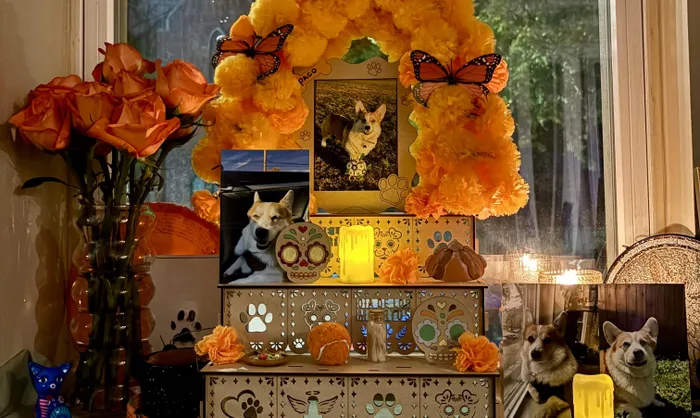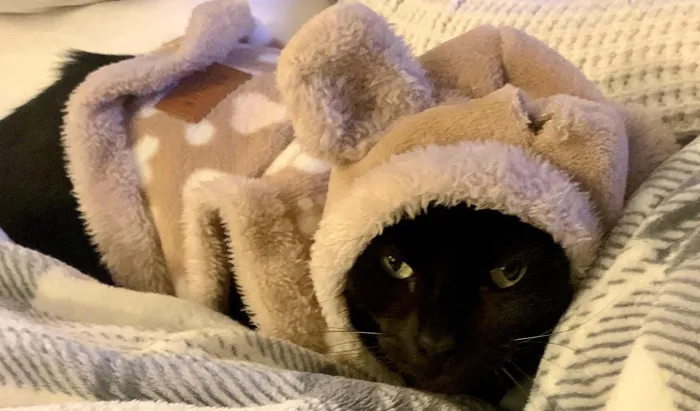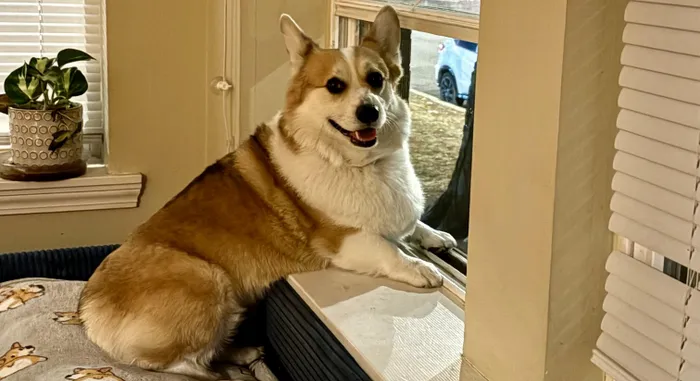
Noemi Gomez built an ofrenda in her Chicago apartment in honor of her corgi, Paco, who died in May.
Image: Noemi Gomez
FOR most of Leila Palacios’s life - through breakups, failed tests and arguments with her older brothers - Kai was there to lick her tears and cuddle.
Kai, Palacios’s cat, died last month after suffering from cancer. But by setting up an altar in her family’s living room - with mementos like the bear costume Kai liked to wear, his chicken- and beef-flavored treats and the orange brush he enjoyed being groomed with - Palacios hopes to feel Kai’s presence again on Monday.
It will be the first night of Día de los Muertos, or Day of the Dead, a traditional Mexican multiday holiday to honor family members and friends who have died. Some observers dedicate each night of the week to celebrate particular loved ones; Monday is for pets.
Mathew Sandoval, author of the illustrated book “Día de los Muertos: A Chicano Arts Legacy,” said the Aztecs - whose traditions inspired the holiday - believed dogs were sacred and could guide spirits in the afterlife. Fernanda Cortes, who shares videos about Latin history and culture on social media, said that belief has remained, especially with Xoloitzcuintles (Mexican hairless dogs).
“If you didn’t treat dogs nicely in your life, they wouldn’t help you in the afterlife,” Cortez said. “That’s how important they were.”
While many people recognize their pets in their holiday celebrations, Sandoval said more people in recent years have created altars - called ofrendas - specifically for their pets.
“Honoring one’s pet, whether it’s a dog or whether it’s just [another] pet, is absolutely in keeping with the tradition of Día de los Muertos,” Sandoval told The Washington Post. “For many of us who are pet owners, it’s hard to draw a distinction between losing the pet that we love [and the people we love] because they really have become a deep companion.”
Ofrendas typically feature photos of loved ones who have died, objects they cherished and food they loved. They often include marigolds and candles that are meant to guide spirits back to the living for a day, and bowls of water to quench spirits’ thirst.

Kai enjoyed being dressed up.
Image: Leila Palacios
Growing up, Palacios watched her grandmother build an ofrenda for family members every fall. When Kai died, Palacios wanted to start her own tradition. She assembled an ofrenda on a mantel above the fireplace in her family’s living room, where they often gather in their Vallejo, California, home.
She put up a photo of Kai lounging on his favorite black and orange blanket, which blended with his fur and made him difficult to find around the house. The ofrenda has helped Palacios remember the cat who clawed at a box of tiny outfits until someone put one on him and jumped on the dining table to demand treats - not the cat who was sick for the last few months of his life, she said.
Palacios, 18, will search for signs of Kai’s presence Monday, she said, but she’ll continue making an ofrenda every October regardless.
“It feels good to just remember the good times,” Palacios said, “and remember the good memories that you have with that person or that pet.”
Some neighborhoods, zoos and animal shelters create community ofrendas for people to post photos of their late pets. Seattle’s Woodland Park Zoo, for example, assembled a community ofrenda near an entrance that recognizes its animals who recently died, including a penguin named Her Majesty Gertrude Sprinklebottom and Alberto Sparklepants the peacock.
Sandoval said Día de los Muertos melds Mesoamerican rituals with Christian traditions that Spanish colonizers brought to the Americas. Even if someone doesn’t observe those customs, Sandoval said, the holiday can help people grieve.
“You might be well-served to handle the grief [of a pet] the same way that you would with the grief of a loved one,” Sandoval said. “And for many of us, that’s why it makes sense to put them on the ofrenda.”

Paco enjoyed looking out of a window in Gomez's apartment.
Image: Noemi Gomez
In Chicago, Noemi Gomez watched TikTok videos last year of people creating ofrendas for their pets, thinking she wouldn’t need to make one for years. Her corgis, Paco and Pollo, were healthy and young.
“When I got Paco, I was very sad and alone, and he came into my life and he made it better,” said Gomez, 29. “And I was never alone after he came home with me.”
But in May, Paco, 4, died after suffering from intervertebral disk disease, a condition that damages dogs’ spinal cords.
In her first-floor apartment, Gomez assembled an ofrenda at a window in her living room where Paco enjoyed sitting and watching dogs walk by. At the top of the ofrenda is a picture of Paco with his right forepaw atop a soccer ball at a nearby park. It reminds Gomez of when she took the picture in 2022: Mexico had been eliminated from the World Cup and she told Paco that he would play better defense than the team representing her parents’ home country.
Gomez placed an orange Kong ball on the ofrenda because Paco loved playing toss with it at a Chicago beach, squeaking it while Gomez was trying to work and hiding it in Gomez’s shoes. On Monday, Gomez plans to add Paco’s favorite treats: a vanilla and peanut butter cookie and salmon-flavored kibble.
“It’s definitely just brought more of a smile to my face,” Gomez said about her ofrenda. “The color is very vibrant, very alive, and [seeing] multiple pictures of him, it’s a great way to remember him.”